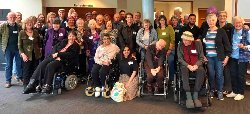Survey highlights true cost of arthritis
18 December 2012
Global
Burden of Disease survey highlights true cost of
arthritis
The World Health Organisation’s Global Burden of Disease survey highlights the true cost of arthritis, says Arthritis New Zealand’s Chief Executive Sandra Kirby. Ms Kirby was referring to a report published in The Lancet.
“The burden of musculo-skeletal conditions, most of which are arthritis, is now ranked as second highest health burden in the world, second only to cancer”.
“Musculo-skeletal conditions are prevalent in all countries and in all cultures and are the most common cause of long term pain and physical disability throughout the world, but poor prioritisation means these conditions are often overlooked.”
“These conditions need to be made a higher public health priority, given their tremendous cost to society. An investment in musculo-skeletal health is an investment in healthier and more productive society”, Ms Kirby concluded.
Global Burden of Disease analysis provides a comprehensive and comparable assessment of mortality and loss of health due to diseases, injuries and risk factors for all regions of the world. The overall burden of disease is assessed using the disability-adjusted life year (DALY), a time-based measure that combines years of life lost due to premature mortality and years of life lost due to time lived in states of less than full health.
ends
Link to report: http://www.thelancet.com/themed/global-burden-of-disease
Key
facts:
• Musculoskeletal conditions include
joint diseases such as osteoarthritis and rheumatoid
arthritis; back and neck pain; osteoporosis and fragility
fractures; soft tissue rheumatism; injuries due to sports
and in the workplace; and trauma commonly related to road
traffic accidents
• They cause pain, physical
disability and loss of personal and economic
independence
• They affect millions of people of all
ages in all cultures and in all countries
o Current
estimates of people affected worldwide (Lancet 15
December 2012)
Back pain 632.045
million
Neck pain 332.049 million
OA
knee 250.785 million
Other musculoskeletal
conditions 560.978 million
• They are the second
greatest cause of disability, as measured by years lived
with disability (YLDs) worldwide and across most regions of
the world (Lancet 15 December 2012)
o As a group
musculoskeletal disorders cause 21•3% of all years lived
with disability (YLDs) (this is second only to mental and
behavioural disorders which account for 22.7% of
YLDs)
o The main contributors are low back pain (83•1
million YLDs), neck pain (33•6 million YLDs),
osteoarthritis (17•1 million YLDs) and the other
musculoskeletal category. Osteoarthritis of the knee
accounts for 83% of the osteoarthritis total.
o The
leading cause of disability worldwide are low back pain
contributing 10•7% of total YLDs (major depression
contributes 8•1%).
• They have the fourth greatest
impact on the health of the world population, considering
both death and disability (DALYs) (Lancet 15 December
2012)
o Musculoskeletal disorders account 6•8%
DALYs
o Low back pain accounts for nearly one half, neck
pain one fifth, and osteoarthritis about 10%.
o Ranking
of major causes of death and disability (% DALYs)
Cardiovascular and circulatory diseases
11•8%
All neoplasms 7•6%
Mental and
behavioural disorders 7•4%
Musculoskeletal
disorders 6.8%
• Disability due to musculoskeletal
disorders is estimated to have increased by 45% from 1990
– 2010 (Lancet). Osteoarthritis is the fastest increasing
major health condition. This relates to ageing of the
population, increased obesity and lack of physical
activity.
• Disability due to musculoskeletal
conditions can be effectively prevented by currently
available interventions, such as accident prevention, modern
treatment of arthritis and injuries, and by rehabilitation.
• The growing burden can be controlled if priority and
resources are given to ensure access to these
interventions.


 Melanie Allison: Local Playwright Casts A Spell Over Hamilton
Melanie Allison: Local Playwright Casts A Spell Over Hamilton Te Kohao Health: New $12M Wellness & Diagnostic Centre Opens In Hamilton ‘Disrupting The Historic Continuum’ For Māori
Te Kohao Health: New $12M Wellness & Diagnostic Centre Opens In Hamilton ‘Disrupting The Historic Continuum’ For Māori Vegetables NZ: Fresh NZ-grown Vegetables Now Even Better Value For Cash Strapped Kiwis
Vegetables NZ: Fresh NZ-grown Vegetables Now Even Better Value For Cash Strapped Kiwis AgriFutures: Supporting The Next Generation To Succeed In Agriculture And Horticulture
AgriFutures: Supporting The Next Generation To Succeed In Agriculture And Horticulture Asian Aotearoa Arts: New Crops, Conversations And Illuminations: Asian Aotearoa Arts 2024 Full Programme Announcement
Asian Aotearoa Arts: New Crops, Conversations And Illuminations: Asian Aotearoa Arts 2024 Full Programme Announcement Arts Access Aotearoa: Accessing The Benefits Of Music Therapy
Arts Access Aotearoa: Accessing The Benefits Of Music Therapy